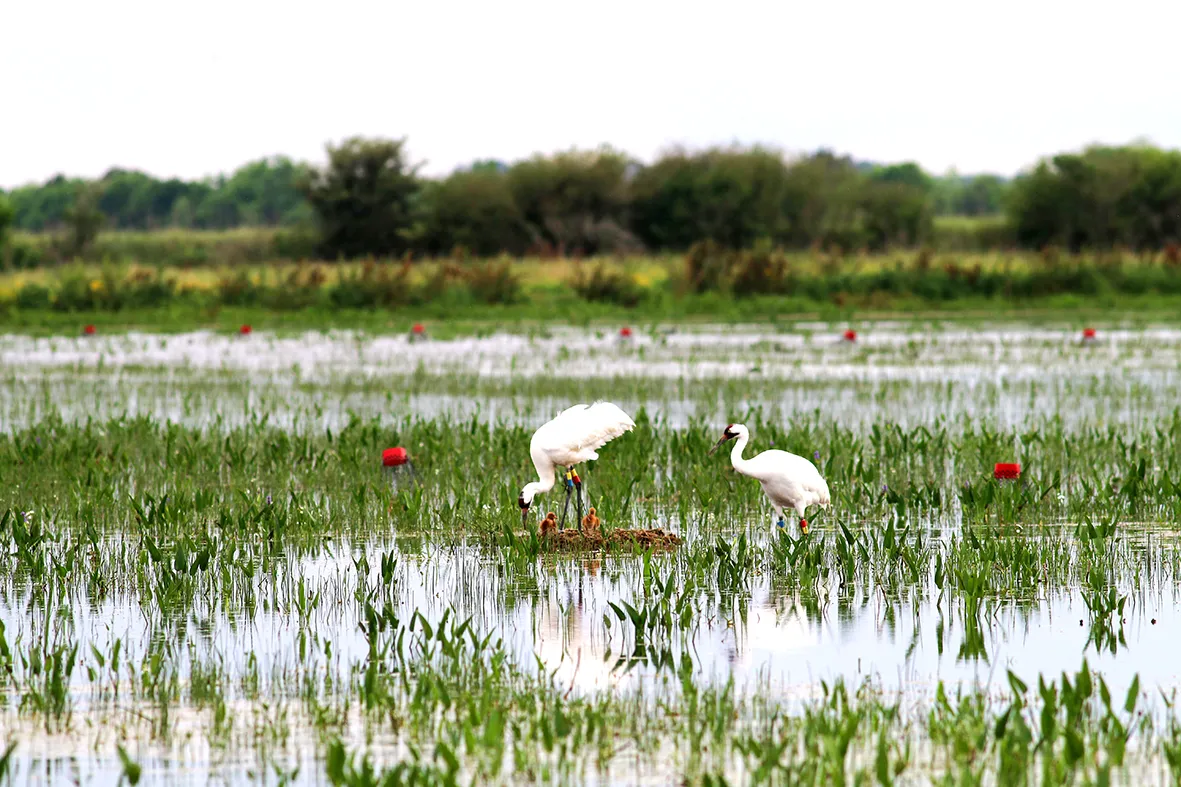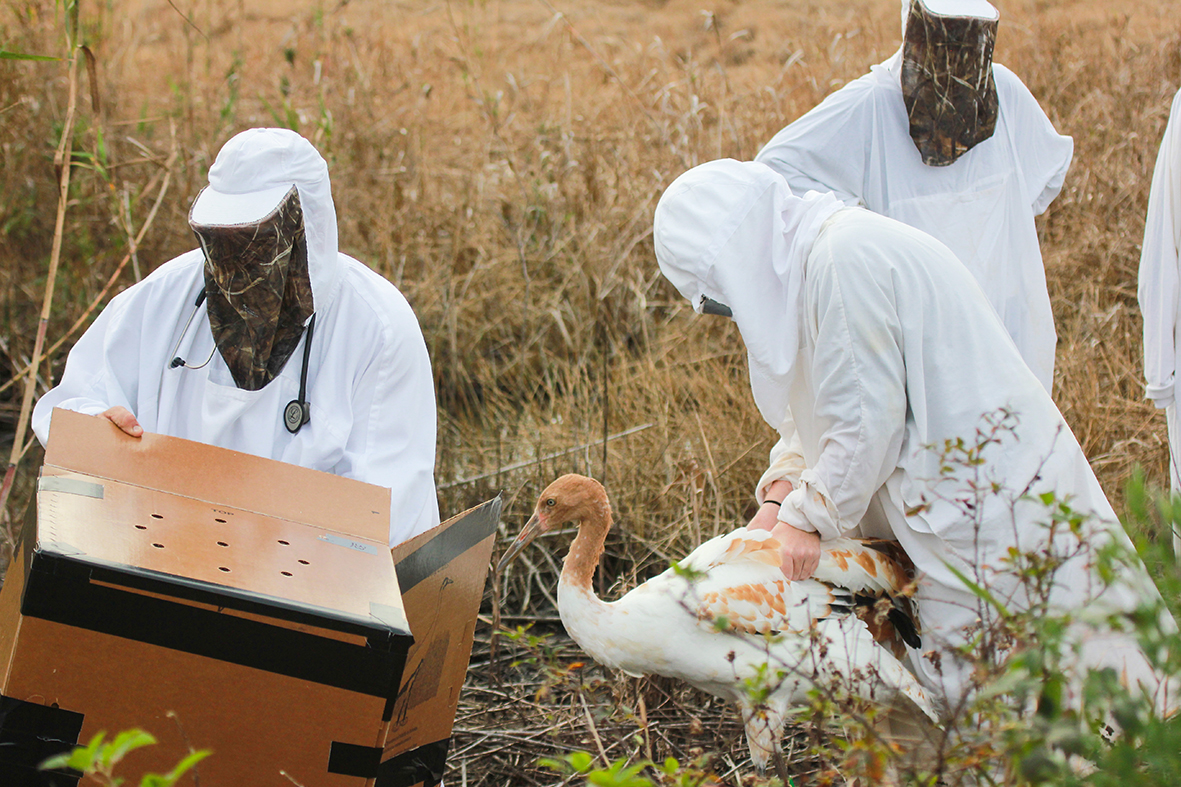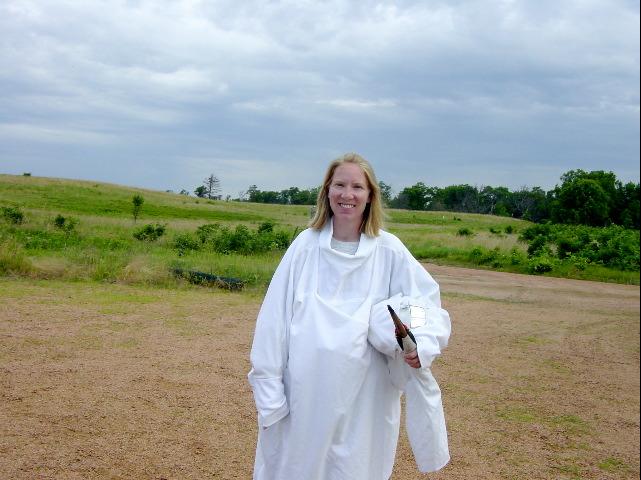
Taking flight: Sarah Zimorski helps whooping cranes make a comeback
In another context, the scene might belong as much in the pages of science fiction as in the marshes of Louisiana. A strange aircraft—small, yellow, discreet—lands in the high grass of an open field. The local residents, still only juveniles but already nearly five feet tall, thin and tawny-feathered, gather around the machine as a figure steps out, a shapeless white billow that rustles in the wind. From its form, in a slow and careful introduction, a face emerges at last. A pointed black bill at the end of a long neck, and a small patch of ruby red on its brow. It seems familiar somehow, and it offers them food before a few more figures—headless this time—examine the colored bands around the birds’ legs, checking boxes and scribbling notes. Then the aircraft leaves and the animals return to business as usual in the swamp. At least until feeding time comes around again, and the Louisiana Department of Wildlife and Fisheries team members shed their disguises and return to their Baton Rouge offices.

And that, says Sarah Zimorski, an LDWF biologist, is how you bring a whooping crane back from the brink of extinction.
One of only two crane species native to North America, the whooping crane, a massive, marsh-dwelling bird with a wingspan of up to 7.5 feet, nearly disappeared from the planet forever in the early 1940s. By 1941, only 21 wild individuals remained in the whole world, six of which resided permanently in Louisiana.
“The other 15 were members of migratory flocks that spent the winter on the Gulf Coast of Texas,” says Zimorski, who works with LDWF’s Whooping Crane Project, a 15-year endeavor to restore the animal to its original Louisiana home. “There had already been some work monitoring them and studying them at the time, but when people realized just how miserable their numbers had become, scientists really started to focus on preventing them from disappearing altogether.”
Once known as a poster child for the Endangered Species Act, says Zimorski, whooping cranes have since multiplied to about 600 in number, including those living in captivity. These positive results stem from the impressive work completed by project members in both Louisiana—where scientists are trying to restore the historically non-migrating population—and Wisconsin, where groups likewise want to restore historically migrating populations, which travel south to the Gulf Coast in winter.
“In reality, whooping cranes were never very plentiful,” says Zimorski. “Before their populations started to drop, there may not have been more than 10,000 or 20,000 individuals in the wild. But as the 20th century wore on and technology progressed, people could suddenly take boats deeper into previously inaccessibly coastal marshes, where the animals’ habitat was. The cranes then became more vulnerable to hunters since they’re so visible.”

But hunting wasn’t completely to blame for the animal’s decline, she says. “Across the country, as wetlands were drained and converted to agriculture, much of the birds’ habitat was lost, and they couldn’t adapt quickly enough,” Zimorski says. “Then, when they started becoming rare and people suspected that they might be going extinct, the cranes became even more valuable, ironically, as stuffed specimens. It sounds ridiculous now, but they became valuable to have in museum collections. Eggs were collected, and some birds were shot and preserved just to put on display.”
Not only that, she continues, but whooping cranes take a long time to reach sexual maturity—three or four years—and only lay two eggs at a time. When Zimorski first started working for the Louisiana project in 2011, having transferred from Wisconsin, the three years spent waiting for wild mating pairs to mature resulted in little success—eggs laid turned out to be infertile, or just didn’t hatch. They continued raising captive-born cranes to prepare them for life in the swamp, but the main goal, she says, is to ensure that the cranes can maintain themselves without human help, mating and raising young on their own without the use of hand puppets.
Then, in April 2016, something amazing happened. The first wild whooping crane hatched in Louisiana more than 75 years after its ancestors almost became the last of their kind.

“Last year was historic for us,” says Zimorski. “There’s still a long way to go, but it’s pretty amazing how far we’ve come.”
To learn more about the Whooping Crane Project and how you can help, visit wlf.louisiana.gov/wildlife/whooping-cranes or check out the project’s Facebook page at facebook.com/lawhoopingcranes.











